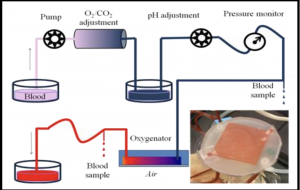Artificial Placenta
Improved postnatal gas exchange in newborn infants with severe form of respiratory failure

Tech ID
11-017
Inventors
C. Fusch
L. Berry
A. Chan
N. Rochow
P. R. Selvaganapathy
J. Brash
G. Fusch
Patent Status
US Patent 9492603
EP Patent 2747807
CA Patent 2845836
Stage of Research
Validation in animal studies
Contact
Sunita Asrani
Associate Director, Business Development and Copyright
Abstract
Lungs perform gas exchange for the human body. In preterm infants, this lung function is impaired, and respiratory distress syndrome (RDS) is the major cause of mortality in neonates (newborn infants under 4 weeks old). Typical clinical routine utilizes mechanical ventilation to support the lungs in oxygenating blood or ECMO (extracorporeal membrane oxygenation) for gas exchange. However, in preterm and term neonates, both strategies are associated with complications. Mechanical ventilation damages the thin lining of the lung and under critically ill conditions (RDS, sepsis, and pneumonia), is insufficient to prevent death or long-term impairment. Currently, ECMO is invasive and requires surgery to connect the device directly to the central blood vessels and high priming volume, needing external blood addition and pump.
The present invention provides the world’s first passive lung assist device that is designed to be pumped by the baby’s heart and capable of gas exchange in ambient air; a concept termed as the artificial placenta. This novel artificial oxygenation device is pumpless, easy-to-use and miniaturized for neonates (to minimize the risk of excessive blood loss). The device can be connected to the umbilical vessels, is biocompatible and minimizes damage to blood cells. The device has been demonstrated in animal trials and is capable of supporting the needs of a 1-2 kg neonate and increase blood oxygen saturation from 70 – 100%.
Applications
- Artificial placenta to improve postnatal gas exchange in newborn infants with severe form of respiratory failure
Advantages
- Provides gas exchange by imitating the placental function in order to prevent damage to the premature lung
- Passive – Pumped by the baby’s own heart and exchanges oxygen with the ambient environment

